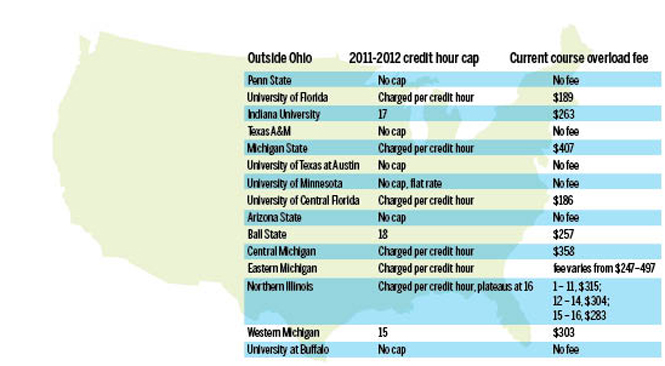How KSU’s new course overload fee stacks up across Ohio
April 18, 2012
Kent State has $170 million of debt. The university must pay back $11 million per year. In order to ensure this, the university has formulated a plan to generate $11.5 million per year.
The university projects it will take in $3.5 million with the $440 course overload fee.
Composition of funding sources (in millions):
$2.0: 1 percent of tuition increase
$3.5: Tuition above full-time
$3.0: Resources allocated through FaSBAC
$3.0: Internal reallocations
$11.5: Total
It has become known as the “ambition penalty.”
Kent State’s new credit-hour surcharge is the second-most expensive surcharge at a public university, trailing by $10, in the state. Each credit hour a student registers beyond 17 will cost him or her $440.
University Library has become the epicenter of student-organized protests and sit-ins. Another is scheduled for Thursday, April 19.
The protesters say they have no intention of backing down. The administrators say it is doubtful the fee will be repealed.
Gregg Floyd, senior vice president of finance and administration, said the number is not random. If the rates are broken down, tuition equates to about $440 per credit hour.
“That is the credit-hour fee,” Floyd said. “Since it was an established credit-hour rate, we felt that it was the fair way to go.”
He said the fee was implemented because the university does not receive enough financial support from the state.
“When we were finally told, after a lot of discussion in Columbus with different representatives and senators and administrators and so forth,” Floyd said, “that we were going to have to solve this problem within our existing tuition formulas, we really tried to come up with that was the most … fair.”
Kim Norris, deputy chancellor for communications for the Ohio Board of Regents, did not say why the state could not provide adequate financing but said Kent State received more capital funding this year than past years.
“There was recently a capital appropriations bill [that doled out money to state universities],” Norris said. “In the previous budget, under a previous administration, there was no capital budget at all.”
“Your university was at that table,” Norris added.
She also said the Board of Regents has no control over the $440 fee, as it does not apply to the constraints of the state’s 3.5 percent tuition increase limit.
“15 credit hours is considered full time or the full load, for the purposes of the tuition cap,” Norris said. “Most of the universities had already implemented something that would address hours students take above and beyond what is considered a full load. These decisions are each made at each university by each administration and by its Board.”
With Kent State’s approval of the new surcharge, only two public universities in Ohio are without a course overload fee — Ohio State and Miami.
The University of Cincinnati approved a tuition increase at its March Board of Trustees meeting. The increase set its fee at $450, making it the most costly in Ohio.
This is, as Provost Todd Diacon called it, the “new normal.” Universities can no longer finance projects and renovations strictly from state funding.
“I don’t think anyone is not sympathetic to the financial concerns of students when they go to school,” Norris said. “There are ways students can save money on their tuition — making sure that they are being very strategic on the type of degree they are pursuing and that they move through [college] quickly.”
Contact Rex Santus at [email protected].












